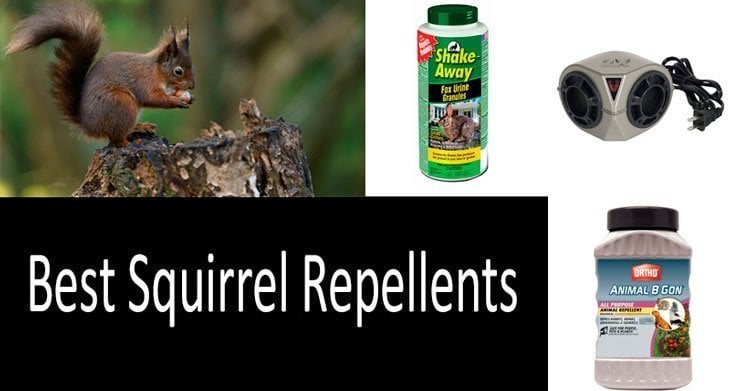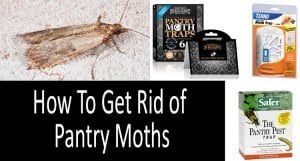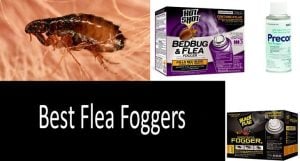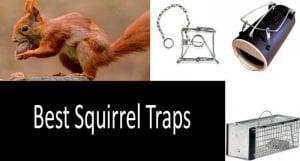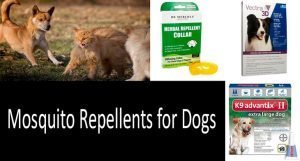Tired of fighting annoying squirrels in your garden and attic, but don’t want to resort to killing? This guide is for you. We’ve covered all types of repellents that would help you eliminate rodents faster but gently and humanely. Here you’ll learn different types of repellents, including natural, chemical, and electronic. You’ll find home-made recipes, in case you like to cook or save a couple of dollars. We’ve also covered TOP 7 Best Squirrel Repellents on the market right now to help you identify options that would work best in your case.
Squirrels are naturally lovely creatures, at least until they damage your crops, invade your attic and destroy your beautiful garden. But don’t worry, you don’t have to kill them: there are many humane ways available to deal with the pests. In this article, we are going to talk about various types of repellents and how they all work.
What You Will Learn from This Guide:
- How do repellents work?
- Types of repellents
- Effectiveness Chart
- TOP 7 Best Squirrel Repellents
- Pros and Cons of using squirrel repellents
- Tips and life hacks
How do repellents work?
The mechanics behind repellents is pretty simple: they work by odor and taste aversion, or fear inducement, according to scientists from University of Florida.
However, it’s important to recognize the fact that animals become accustomed to repellents over time: you will have to either substitute one repellent over the other or switch to an entirely different method.
Also, if animals find themselves in dangerous situations, like lack of food, the need to protect their litters, they will ignore the repellents altogether to save themselves and their offspring.
Taste and odor. Among those deterrents that work through taste and odor aversion are pepper, peppermint, tarragon, garlic, various essential oils, castor oil, diatomaceous earth, and putrescent egg solids.
Fear inducement repellents contain the ingredients of animal origin. Enemy urine (of coyotes or foxes), dried blood and hair induce panic in squirrels and make them leave the treated area, as confirmed by researchers from the College of Natural Sciences.
While the effectiveness of such deterrents is questionable, they are still recommended as the first line of defense against nuisance wildlife.
These are some factors that can affect the effectiveness of such repellents:
- the stage of growth of the repellent-treated plants;
- how long it takes for an animal to consume a plant;
- repellent treatment frequency;
- the number of wildlife animals in your area;
- individual taste and smell preferences and sensibilities of each animal.
Havahart, Shake Away, Eco-Defense, Ortho, Bonide, Expel and others are the renowned brands manufacturing animal repellents. The ingredients of these products will likely differ, but their effect is pretty similar.
Now let’s cover the types of repellents in more details.
Types of Squirrel Repellents
Natural repellents
Natural repellents are those of plant origin. They primarily work by odor or taste aversion.
Consider planting peppermint across the perimeter of your garden. Other plants that you can consider planting include any type of narcissus bulb (daffodils, paperwhites, jonquils), geranium, and hyacinth. These plants send a message of toxicity odor to the rodents that might keep them at bay at least for a while.
You can also buy ready-made natural sprays that already contain naturally deterrent smells or odors in regular stores or online. These sprays usually contain one or more of the following ingredients: garlic and castor oils, other essential oils, tarragon, pepper, among others.
Homemade repellents
Knowing that some plants and oils can repel squirrels away from your property, you can try and make a homemade natural deterrent at home.
1. The easiest way, which doesn’t require you to cook, is to use regular pepper flakes. Spread them all over your garden. The idea here is to deter squirrels away from your plants with the smell and taste of pepper flakes.
Other recipes described hereafter require a little more effort:
2. Fresh pepper recipe:
Take three cayenne peppers and put them in a blender or a food processor. Strain the pulp using cheesecloth, and mix the resulting solution with 1 gallon of water. Add 1/3 of this mixture to a spray bottle; dilute it with water to your discretion (the less dilution the better), and add 1 teaspoon of vegetable oil or dish soap. You’re set! Spray the repellent near plants, on trees, wood fences, etc. Re-apply whenever necessary (after rain or watering plants).
3. Cooked pepper recipe:
Bring 2 quarts of water to boil. Take one yellow onion, finely chop it, and add it to a boiling water. Next, take 2 jalapeno peppers, chop them up with seeds (take necessary precautions while cutting jalapenos: wear rubber gloves, or wash your hands immediately after). Put peppers into the boiling water. Add 1 tablespoon of cayenne pepper. Leave the mixture simmer for 20-30 minutes. Then let it cool and strain it using cheesecloth. Add the strained solution to the spray bottle. Apply the spray to the plants, or any other places where you’ve seen rodent activity. Re-apply the spray following precipitation.
Chemical repellents
For the sake of simplicity, we’ve called repellents that contain animal products – chemical repellents.
These types of products usually contain enemy blood traces, predator urine, feather meal, and other ingredients that can scare rodents away.
The general rule is that squirrels (and other rodents likewise) get scared when feeling or smelling their enemies, or predators.
Another common ingredient in these types of repellents is the putrescent egg.
Putrescent egg whole solids are approved by scientists for minimum risk pesticide use. Putrescent eggs are cracked eggs that are not fit for human consumption.
The rotting of proteins and amino-acids leads to the formation of substances that are unbearable for rodents and some other animals creating a repelling effect.
Fear Inducement Devices
These devices usually look like scarecrows that emit frightening and scary sounds for rodents. The realistic looking predator projects an image of active hunting and therefore is thought to intimidate rodents and some other animals.
The effectiveness of these devices is quite questionable. However, you might try it as a short-term solution.
If you don’t want to buy a fake and frightening scarecrow that might somehow mess up the design of your beautiful garden (some of these devices aren’t at all pretty), then you may purchase a blinking light station or motion sprinkler that will repel squirrels when they approach a device at a particular distance.
Electronic Repellents
Electronic repellents emit high-frequency sound waves that are unbearable for rodents.
While the effectiveness of such devices has not been confirmed by serious scientific research, many buyers notice that such devices, in fact, help a great deal.
It’s important, however, to read and follow the instructions carefully. To ensure the device will properly work, free your garden or attic from debris and spare furniture: ultrasound waves cannot travel through hard surfaces and are absorbed by soft ones.
Effectiveness Chart
All of them work practically the same with the same rate of effectiveness: use it short-term and/or as a preventative measure; most of them require multiple re-application (esp. after rain); and all of them are ignored if squirrels are hungry. However, some of them are more reliable and effective than others:
| Type of repellent | Notes | Effectiveness |
| Natural Rodent Defense Spray |
Contains plant-origin ingredients (garlic, peppermint, rosemary oils, white pepper) with questionable effectiveness | 5 |
| Home-made Look for recipes hereinabove |
Requires additional effort of cooking, diluting, etc | 5 |
| Chemical Shake-Away Fox Urine Granules |
Based on prey-predator relationship, and thus considered more effective than natural | 7 |
| Fear Inducement Scarecrow Motion Activated Sprinkler |
Squirrels get used to a deterrent or might ignore the scarecrow/water altogether | 5 |
| Electronic Victor Heavy-Duty Sonic PestChaser |
Based on ultrasound high-frequency waves unbearable to rodents For low to medium population of squirrels Can be used long-term | 7 |
Now let’s cover some of the most effective squirrel repellents (also included in the above table) along with their differentiating features.
TOP 7 Best Squirrel Repellents
Rodent Defense Natural Spray – repels by smell and taste
This product from Grandpa Gus’s works as a deterrent for many small critters.
The main ingredients are garlic, peppermint, and rosemary oils, and white pepper. The combined ingredients irritate affected rodents and prevent them from destroying plants, trees, or any other objects.
It’s advised that you do not apply the spray directly onto plants. Build or mount a barrier inside or outside the perimeter of an area that you want to preserve, and apply the spray generously there. Be careful when applying it on painted surfaces as the spray might stain.
It’s easier to use in the attic: apply the spray wherever you see rodent activity or otherwise spray the whole inside perimeter of the attic. The buying options include either a gallon or 32 ounces.
Price: Check current price
Shake-Away Fox Urine Granules – repels by smell
Shake-Away is not an unknown name in the world of rodent repellers. While we’ve put the product under the chemical-based deterrents, it’s not entirely so.
Shake-Away doesn’t contain any harmful chemical pesticides that can harm other animals or the environment. In fact, all Shake-Away consists of is fox urine granules.
The product takes advantage of the important predator-prey relationship that exists in the wildlife and uses animal primary instinct of fear.
Smelling the enemy urine from afar, squirrels (and many other rodents for that matter) will be driven away from your property.
The manufacturer claims that the granules are impervious to weather, thus may be left after rainfall. However, for better results, we still recommend you change the granules or add fresh ones after a heavy rain.
Price: Check current price
Ortho Granules with Putrescent Whole Egg Solid – repels by smell
Another similar option is Animal B Gon by Ortho. There are two options available for purchase: either a gallon or two pounds.
Active ingredients include putrescent whole egg solid among more natural ingredients, such as rosemary, cinnamon, and peppermint oils.
Spread the granules at the base of your plants to limit their attractiveness to rodents. Try not to apply the product directly on the plants grown for human consumption, but rather put the granules somewhere nearby. Re-apply after 30 days, after heavy rain, or whenever necessary.
Price: Check current price
Scarecrow: Eagle with Flashing Eyes – repels by sight
While the device might look like an absolutely irrelevant addition to your garden, some people (the manufacturer included) claim that it works well at repelling rodents short-term.
Unfortunately, squirrels, or any other animals for that matter, are smart creatures, and as soon as they figure out that the eagle doesn’t really harm them in any way, they start to completely ignore the fake animal. However, who knows, maybe it’s going to work for you.
The Hoont Garden Scarecrow Eagle is a model of a realistically looking predator that’s supposed to deter other birds and some rodents. The manufacturer claims the Eagle looks intimidating and actively hunting, which frightens pests and other birds away.
The device is solar powered. The Eagle emits loud scary sound and flashes light whenever pests enter an area within the 5 ft. distance from the device.
The device is quite large and thus looks more realistic. It’s made of high-quality plastic and hand-painted for an effective appearance.
Price: Check current price
Motion Activated Sprinkler – repels by water
This Motion Activated Sprinkler from Hoont monitors an area approximately within 650 sq ft and detects unusual activity within 30 ft. The sensitivity and detection range can be easily adjusted.
The device detection angle is 120 degrees. The sprinkler emits water for 5 seconds scaring away rodents and ensuring low water consumption. The device runs on batteries.
Price: Check current price
Victor Heavy-Duty Sonic PestChaser – for indoors
Victor is another well-known and respected name in the world of animal control products.
Victor PestChaser works just like any other ultrasonic device, by emitting high-frequency ultrasound waves inaudible to humans and non-rodents animals, but intolerable to rodents, squirrels not excluded.
The device has to be plugged in and comes with a 6-foot cord. LED light indicates if the unit is working properly. PestChaser works well for huge spaces, so might be worth a purchase for your attic.
Unfortunately, though, the manufacturer doesn’t say if the device can be used outdoors. So, let’s say that’s for indoors only.
Aspectek Upgraded Powerful Yard Sentinel – for outdoors
The device from Aspectek covers an area of 5,000 sq ft and can be used outdoors.
Aspectek Yard Sentinel has three working modes. The gadget emits a forward direction sound with a range of 170 degrees horizontal and 60 degrees vertical.
The real advantage of Aspectek is that the sound can be adjusted (particularly useful if your hearing is sensitive). You can also adjust it for a specific animal that you want to repel.
Comes with AC adapter and 33 ft extension cord but can be run on 4C batteries as well (not included). The manufacturer says that it provides 4 multi-charging options.
FAQ
Should I reapply natural repellents after rain?
Yes, you should. Even if the manufacturer claims that there is no need to replace/change or add new portions of a repellent, we still recommend you do. Especially after a heavy rain.
May I eat fruits and vegetables treated by such natural spray?
It is not advisable you consume fruits or veggies treated with a repellent, especially if you are allergic to any of its components. That is why we recommend using repellents either by placing them directly underneath the plants or by mounting a barrier around the plants and applying the repellent on there.
Can you recommend squirrel deterrents for bird feeders?
Yes, you can, in fact, use any deterrent that contains pepper. Spray it directly on the feeder to repel annoying squirrels, while pepper is unpleasant for rodents, birds don’t mind it.
Otherwise, buy special squirrel-resistant bird feeders that either rotate when the squirrel tries to climb on the feeder or has a plastic dome attached to it underneath which makes it difficult for squirrels to climb over.
Can you recommend squirrel deterrents for gardens?
You can use all repellents discussed earlier in this article (natural repellents, homemade sprays, fox urine or putrescent egg solids, and electronic devices) except for PestChaser from Victor which is suitable for indoors only.
Pros & Cons of using squirrel repellents
| Pros |
|---|
|
| Cons |
|
Tips and life hacks
- The trick of using the repellents is to start applying them as soon as you notice squirrels on your property.
- Then, use different types of repellents, either interchangeably or one after another, so the squirrels don’t get accustomed to it.
- Follow preventative measures, like getting rid of garbage, sealing trash can and other possible food sources, using special bird feeders, installing protective plastic or metallic structures around trees or elsewhere to make it harder for squirrels to climb on. You might want to read the full list of preventative measures in detail in our article: How to Get Rid of Squirrels {insert link to the article}
Best-Selling Squirrel Repellents | Comparison Table
Conclusion
While the effectiveness of squirrel repellents might be questionable, you can still try to use them as a preventative or short-term measure, or for low population of squirrels.
You can also try to boost up the repelling results by changing repellents over time, using different types of repellents at once, or using them in combination with other measures.

